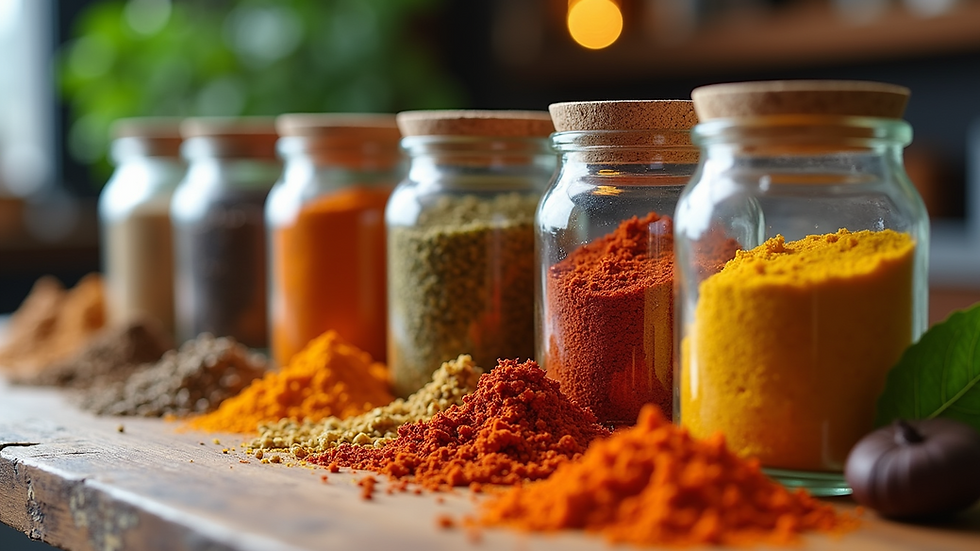Unlocking the Secrets of Successful Spice Exporting Strategies
- Harvestia
- Oct 13
- 4 min read
Step into the dynamic world of spice exporting. With a booming global demand and a growing interest in culinary diversity, this industry offers vast potential. But success in spice exporting isn't just about having the right products; it's about implementing effective strategies. This post will explore how to navigate the world of spice exporting, from understanding market dynamics to mastering logistics.
Understanding the Spice Market
To excel in spice exporting, comprehending the market landscape is essential. The spice market features a range of flavors and aromas, each serving different culinary styles and consumer tastes.
For example, turmeric has surged in popularity, with reports indicating a 30% annual growth rate, largely due to its anti-inflammatory properties. On the other hand, familiar staples like black pepper remain crucial in cuisines across Asia, Europe, and the Americas.
Identifying your target market is a significant step. Are you eyeing Europe or the expanding markets in Asia? For instance, the European spice market was valued at approximately $2.4 billion in 2022, with organic spices seeing a steady rise. Each region also presents different regulatory compliances, impacting your exporting strategies.
Sourcing Quality Spices
Once you've assessed the market, the next focus must be on sourcing high-quality spices. The quality of your spices plays a critical role in establishing your brand's reputation and driving sales.
Building relationships with local farmers can lead to a consistent supply of premium spices. You might consider collaborating with suppliers who follow sustainable farming practices. For instance, sourcing from farmers in Kerala, India, who grow organic cardamom not only guarantees quality but also supports sustainable agriculture.
Visiting spice farms in person can offer you firsthand insights, ensuring you've selected the best products. This transparency builds trust and enhances your business partnerships.
Compliance and Regulations
Navigating the maze of regulations is vital for your spice export success. Each country has distinct rules regarding spice importation, covering aspects like phytosanitary regulations and labeling requirements.
To safeguard your shipments, get familiar with the specific regulations in your target market. For example, the United States mandates that imported spices meet certain import standards to prevent contamination. Depending on your products, obtaining certifications such as organic or non-GMO can significantly boost consumer appeal.
Engaging a customs broker can ease the burden of paperwork, ensuring that everything meets safety standards. Statistics show that working with an expert can reduce delays by as much as 40%.
Packaging and Labeling
Packaging and labeling are not just practical; they profoundly influence consumer choices. Select packaging that safeguards the spices during transit and stands out on shelves.
Adopting eco-friendly packaging can resonate well with customers. A survey found that 66% of consumers prefer sustainable packaging, which can enhance brand loyalty.
Your product labels should provide comprehensive information including spice names, origins, and certifications. Clear, visually appealing labels can help your spices attract attention in a crowded marketplace.
Marketing Your Spices
With your spices ready to export, crafting an effective marketing strategy is the next move. Create a robust online presence to connect with potential buyers.
Using a well-structured website can serve as a vital platform to display your offerings. For instance, incorporating high-quality images and detailed product descriptions can enhance the user experience. Similarly, social media channels like Instagram and Facebook can help you reach a wider audience.
Participating in trade shows can be invaluable. For example, the Specialty Food Association's Fancy Food Show sees thousands of potential buyers gathered in one place, providing ample networking opportunities.
Logistics and Distribution
Efficient logistics is a cornerstone of successful spice exporting. The right shipping method is crucial to ensure your spices arrive in optimal condition.
Air freight is faster, making it suitable for high-value spices like saffron, while sea freight is more cost-effective for bulk shipments of less perishable spices. Costs for air freight can exceed $10 per kilogram, whereas sea freight might average $3 per kilogram.
Partnering with logistics professionals can provide insights into the complexities of shipping food products, ensuring compliance with regulations and minimizing disruptions.
Building Relationships with Buyers
Creating strong, lasting relationships with buyers can significantly impact your success in the spice industry.
Regular communication fosters trust. Consider providing updates on new products or sending samples to potential buyers. In fact, studies show that businesses that maintain strong client relationships see a 20% increase in sales.
Encouraging feedback can also be fruitful, as it helps you stay in tune with emerging market trends and preferences.
Embracing Technology
In a world increasingly influenced by technology, embracing digital tools can streamline your spice exporting business.
Adopting inventory management software keeps operations organized, reduces errors, and enhances efficiency. Moreover, data analytics can shed light on market trends and consumer behaviors, equipping you to make more informed business decisions.
Prioritizing Sustainability
Sustainability is more than just a trend; it is a vital part of modern spice exporting. Increasingly, consumers are considering the environmental impact of products before making purchases.
Consider sustainable sourcing practices that benefit both the environment and your business. For example, supporting farmers who practice organic agriculture not only elevates your brand but appeals to eco-conscious customers.
Promoting your sustainable practices in marketing efforts can attract a loyal following. Research indicates that companies prioritizing sustainability can see up to a 50% increase in customer loyalty.
The Road Ahead
Navigating the spice export industry demands knowledge, strategy, and dedication. By understanding the market, sourcing quality spices, ensuring compliance, and adopting effective marketing, you can tap into the immense potential of this industry.
With a steady rise in global spice demand, now is the perfect opportunity to explore what this vibrant market has to offer. With careful planning and execution, your passion for spices can blossom into a thriving exporting business.




Comments